The cab cars need to be able to connect through to adjacent cars, because often cab cars will wind up in the middle of a consist. There’s not much you can do to the aerodynamics when you have a cab end and a diaphragm to work around.
You are using an out of date browser. It may not display this or other websites correctly.
You should upgrade or use an alternative browser.
You should upgrade or use an alternative browser.
Metra signs contract for new passenger cars
- Thread starter DSS&A
- Start date

Help Support Amtrak Unlimited Discussion Forum:
This site may earn a commission from merchant affiliate
links, including eBay, Amazon, and others.
west point
Engineer
If you streamline a cab car you may reduce the inside passenger capacity ?
Yes, that is a serious limitation GO has encountered with their new cab cars, seen here:The cab cars need to be able to connect through to adjacent cars, because often cab cars will wind up in the middle of a consist. There’s not much you can do to the aerodynamics when you have a cab end and a diaphragm to work around.

The older ones had the diaphragm and they've retained some so they can be used mid-train.

MisterUptempo
Lead Service Attendant
Metra also has a tendency to keep their rolling stock for forever and a day. To that end, some of the older cab cars have had the controls removed and have gone on to serve as trailer cars, which would not be possible with a more aerodynamic front end.The cab cars need to be able to connect through to adjacent cars, because often cab cars will wind up in the middle of a consist. There’s not much you can do to the aerodynamics when you have a cab end and a diaphragm to work around.
Metra also has a tendency to keep their rolling stock for forever and a day. To that end, some of the older cab cars have had the controls removed and have gone on to serve as trailer cars, which would not be possible with a more aerodynamic front end.
Indeed. I often see a Heritage Corridor consist deadheading from Union Station to Western Avenue yard in the morning on my way to work. Recently, the consist has been 4 or 5 (I forget the count) current or former cab cars, and maybe one regular coach.
Also, Metra has in the past (don’t know if they’re still doing it now) split consists to run shorter midday trains, leaving some of the cars at the downtown terminal to be added to another train in the afternoon. Having two active cab cars allows this to be done without any complicated switching.

$10.37
IA, Iowa Old Vintage Antique Collectables For Sale Illinois Central Railroad Bridge Missouri River 1940
Vintage Postcards - Towns in 50 USA States

$20.99
$27.98
Walthers Trainline HO Scale Model Flatcar with Logging Crane - Alaska Railroad 17104, Blue
Amazon.com

$4.00
Completion of the First Transcontinental Railroad trading card (Promontory Summit Utah, 5/10/1869) 2009 Topps Heritage #113
Autograph Warehouse (AW Authentic)

$10.37
IA, Iowa Old Vintage Antique Collectables For Sale Newton and Northwestern Railroad Bridge Unused
Vintage Postcards - Towns in 50 USA States

$16.99
$22.99
Fodor's Best Road Trips in the USA: 50 Epic Trips Across All 50 States (Full-color Travel Guide)
Amazon.com

$235.99
Pennsylvania Railroad William Atterbury Signed Auto Mounted Cut Index Card D13 - College Cut Signatures
Sports Memorabilia

$10.37
IA, Iowa Old Vintage Antique Collectables For Sale Illinois Central Railroad Bridge Missouri River Unused
Vintage Postcards - Towns in 50 USA States
Except for high speed trains, I wonder how much streamlining would accomplish in a normal speed train? I suppose there have been studies to find out, but I suspect that the "streamlining" may be more for projecting a stylish modern image, than anything else....not sure... 
cirdan
Engineer
- Joined
- Mar 30, 2011
- Messages
- 3,940
Except for high speed trains, I wonder how much streamlining would accomplish in a normal speed train? I suppose there have been studies to find out, but I suspect that the "streamlining" may be more for projecting a stylish modern image, than anything else....not sure...
I understand that the shape of the front end only has little effect on the overall drag at typical commuter train speeds. What may have a bigger effect is the overall geometry, including things such as pipes and other assemblies sticking out, including those on the underside of the train where most people won't see them.
That said, inclining windshields rather than having them flat cuts down on reflection and hence improves the engineer's view when light conditions are poor. This may be the real reason many locomotives and cab cars have inclined windshields.
cirdan
Engineer
- Joined
- Mar 30, 2011
- Messages
- 3,940
The cab cars need to be able to connect through to adjacent cars, because often cab cars will wind up in the middle of a consist. There’s not much you can do to the aerodynamics when you have a cab end and a diaphragm to work around.
There have been quite credible attempts at partially streamlining trains without sacrificing diaphragms.
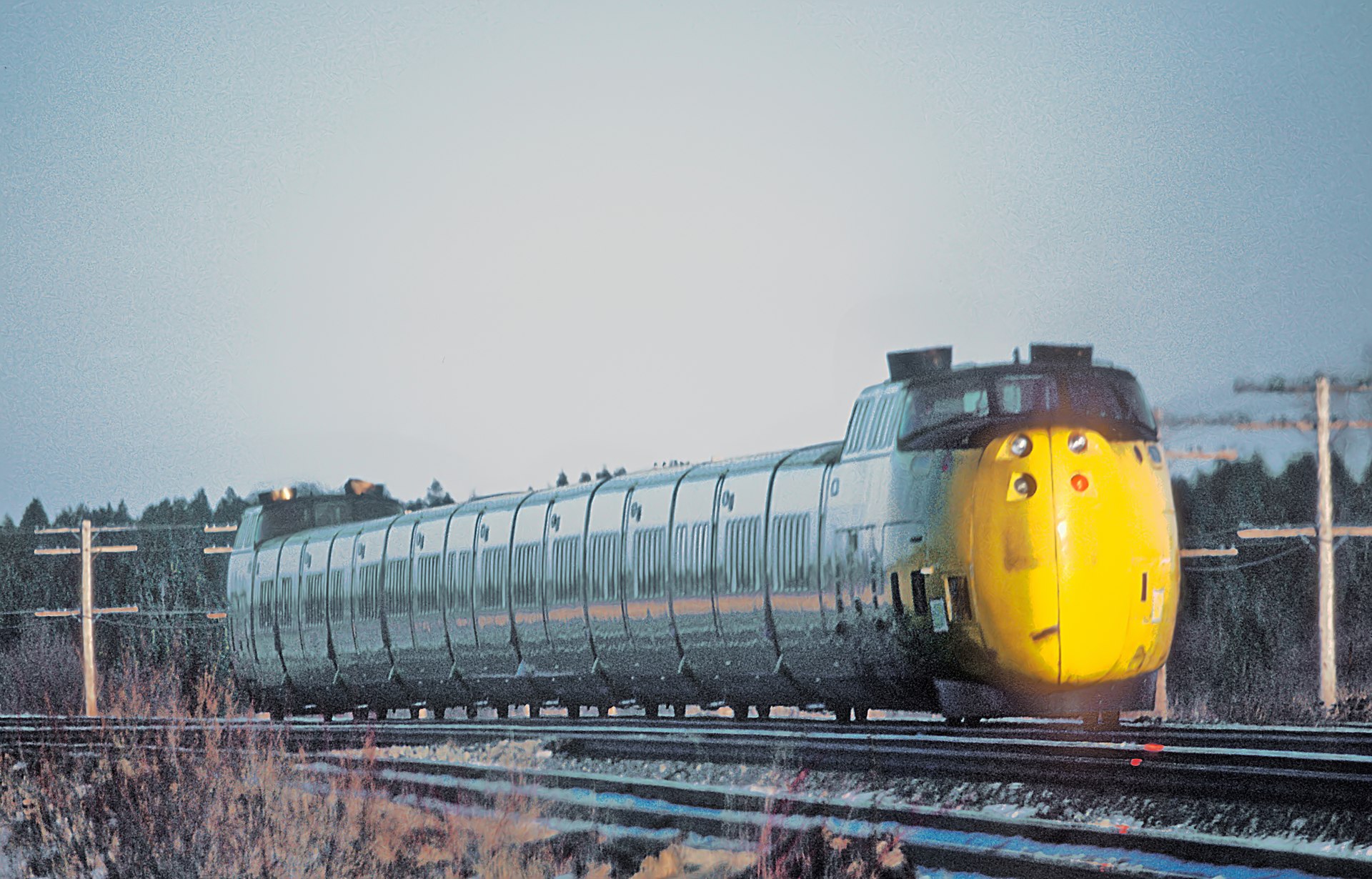
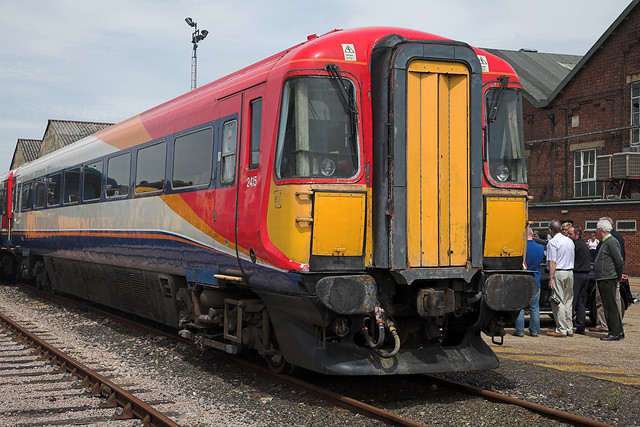
Last edited:
jis
Permanent Way Inspector
Staff member
Administator
Moderator
AU Supporting Member
Gathering Team Member
I suspect it also makes room for more robust collision posts and crash energy management collapse zones.Except for high speed trains, I wonder how much streamlining would accomplish in a normal speed train? I suppose there have been studies to find out, but I suspect that the "streamlining" may be more for projecting a stylish modern image, than anything else....not sure...
cirdan
Engineer
- Joined
- Mar 30, 2011
- Messages
- 3,940
I suspect it also makes room for more robust collision posts and crash energy management collapse zones.
Could be.
In which case that would also be an argument against diaphragms as having a huge aperture in the front of the car is bound to affect its crashworthiness.
jis
Permanent Way Inspector
Staff member
Administator
Moderator
AU Supporting Member
Gathering Team Member
I am no expert in this, but my understanding is that the primary components of crashworthiness are collision posts and crumple zones. Neither of those seem to implicitly exclude the possibility of having a gangway. The collisions posts are usually adjacent to the two edges of the gangway.Could be.
In which case that would also be an argument against diaphragms as having a huge aperture in the front of the car is bound to affect its crashworthiness.
cirdan
Engineer
- Joined
- Mar 30, 2011
- Messages
- 3,940
I am no expert in this, but my understanding is that the primary components of crashworthiness are collision posts and crumple zones. Neither of those seem to implicitly exclude the possibility of having a gangway. The collisions posts are usually adjacent to the two edges of the gangway.
I am no expert either, but looking at it from a physics perspective, I would say it's all about the energy having to go somewhere.
Crash posts work on the principle that the car body remains fundamentally intact and that something else will absorb the energy. For example the truck that you are hitting. Or the next car along in the train. In other words they only really work as long as something other than you is the weakest link.
Crumple zones are structures designed to absorb as much energy as possible during deformation.
If you have crumple elements across, say, two thirds of the width of the nose cone versus the same elements across the full width, those elements are going to have to absorb 50% more energy, which means that if they are made using the same method they need to be 50% deeper.
MisterUptempo
Lead Service Attendant
A small, but interesting, note about something I missed in December, 2022.
Metra, on its Instagram page, allowed the public to vote on two possible exterior paint schemes for its Coradia Multilevel cars. Here they are-
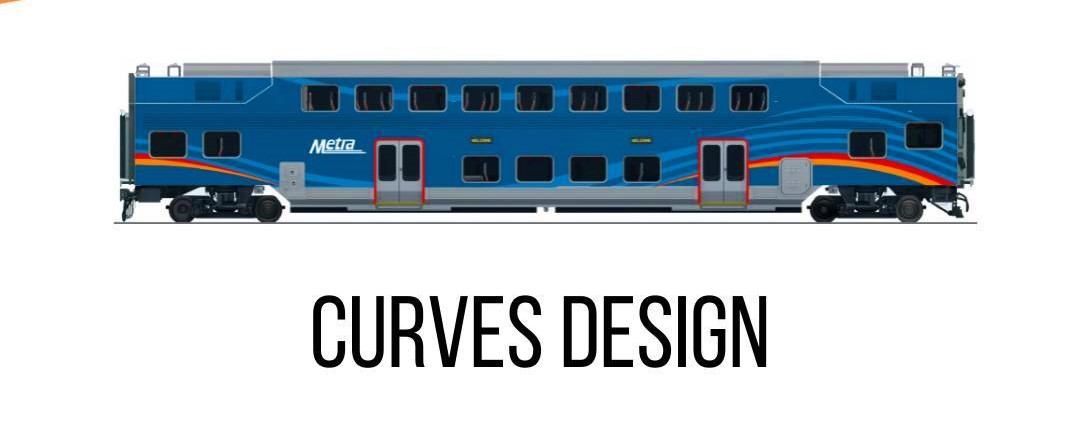
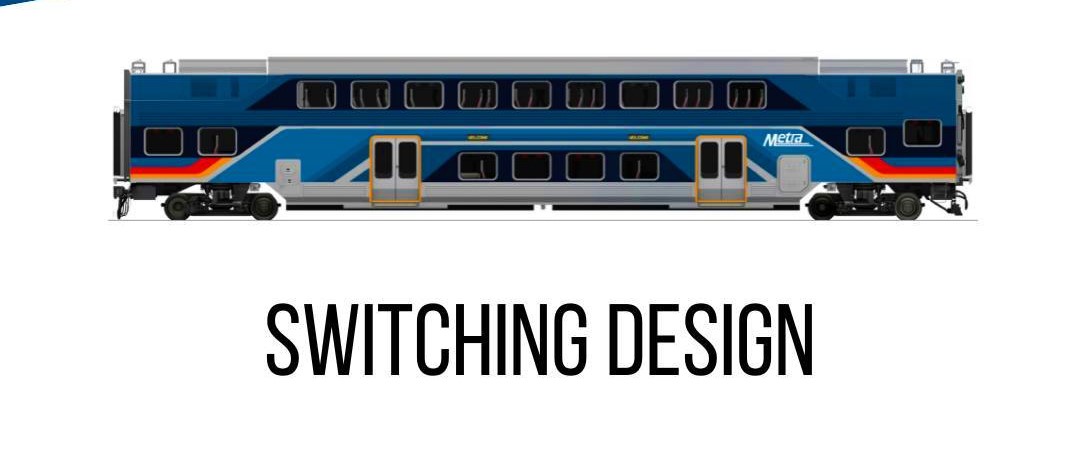
After allowing voting for a week, the "Switching Design" easily beat out the "Curves Design", 79% to 21%.
While I prefer "Switching" to "Curves", I think the design presented in the Alstom-produced announcement video offers the best design overall. This rendering shows a lower level done in Metra Blue, with a large logo, while the upper level retains Metra's traditional stainless steel, which might make a mixed consist of Coradias and gallery cars look less jarring-
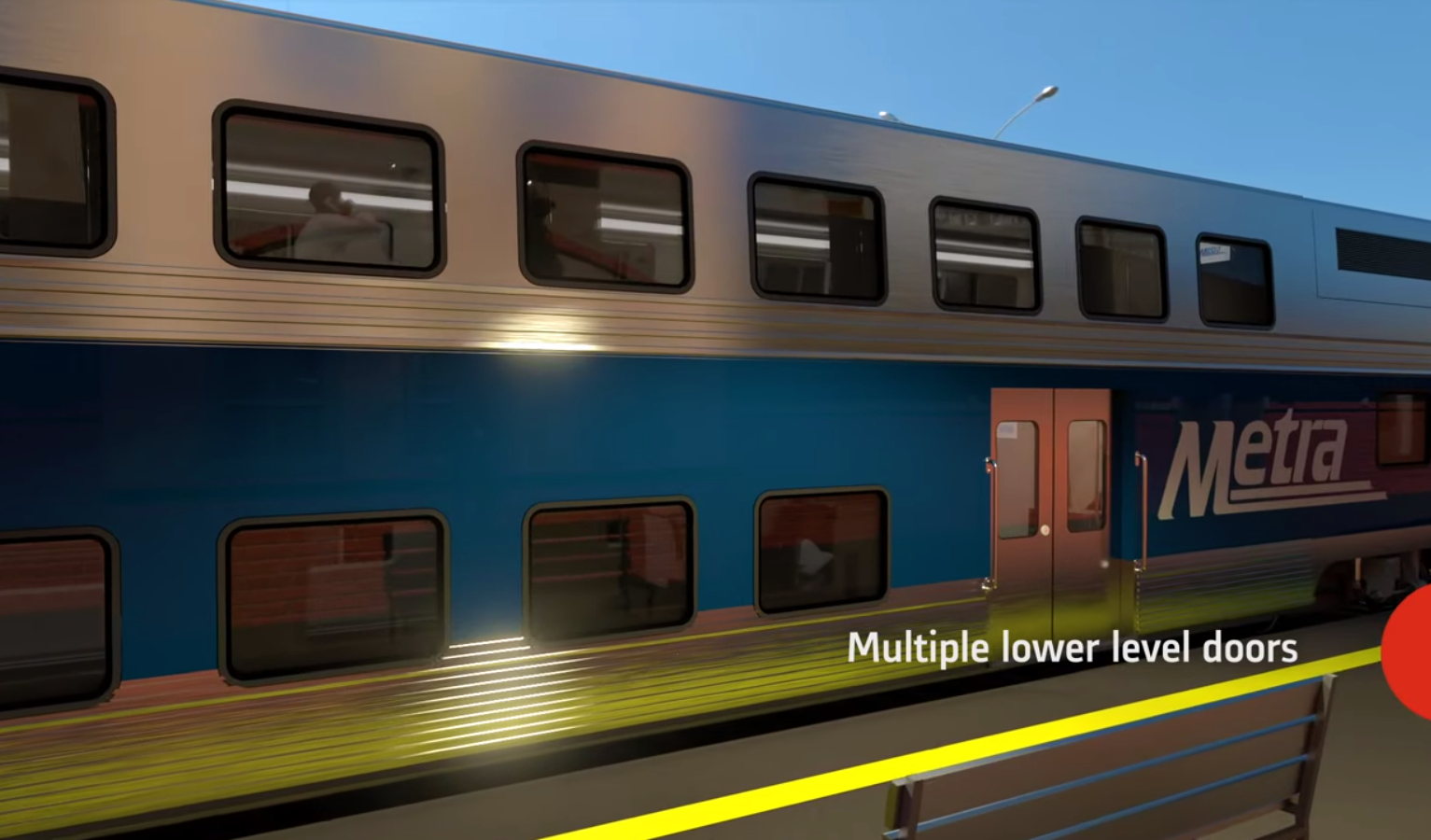
Metra, on its Instagram page, allowed the public to vote on two possible exterior paint schemes for its Coradia Multilevel cars. Here they are-


After allowing voting for a week, the "Switching Design" easily beat out the "Curves Design", 79% to 21%.
While I prefer "Switching" to "Curves", I think the design presented in the Alstom-produced announcement video offers the best design overall. This rendering shows a lower level done in Metra Blue, with a large logo, while the upper level retains Metra's traditional stainless steel, which might make a mixed consist of Coradias and gallery cars look less jarring-

mfastx
Service Attendant
Can't wait for more mismatched liveries!
rookzie
Train Attendant
The cab cars need to be able to connect through to adjacent cars, because often cab cars will wind up in the middle of a consist. There’s not much you can do to the aerodynamics when you have a cab end and a diaphragm to work around.
Metrolink's cab cars can't be used in the middle either. I don't know if they've had an issue with it
Could be.
In which case that would also be an argument against diaphragms as having a huge aperture in the front of the car is bound to affect its crashworthiness.
I'm under the impression that Metrolink's foremost concern had to do with impact safety, following a couple of high-profile incidents that occurred in 2005 and 2008 ─ the 2005 Glendale collision with an SUV (the driver of which reportedly contemplating suicide had developed "cold feet" at the last minute); and the 2008 Chatsworth train collision with a UPRR freight.
While the Glendale incident resulted in more collateral damage with a stationary freight and a another passing Metrolink commuter than it had sustained with the initial impact with the SUV, the Chatsworth incident was a head-on with a UPRR freight (reportedly due to mobile phone texting distraction by the engineer of the Metrolink train).
Whether or not electing go with the cab-control cars chosen has become an operational-logistical issue with Metrolink, selecting the semi-streamlined design (not necessarily award-winning aesthetically) might have been a more decisive criterion as trade-off for the sake of safety of what had been offered in response to any RFI and RFP at that period in time. All this notwithstanding, a leading Hyundai-Rotem bi-Level cab car obtained in a fleet order since the previous two incidents was involved in a collision with a semi-trailer truck in Oxnard, Ca. in 2015. This incident resulted in the death of the engineer a week later. The crash energy management (CEM) system of this equipment reportedly had not be activated during this incident, and the primary cause of injury was determined to have been the overturning of the railcars and subsequent passenger and crew impacts with hard interior surfaces. I personally know how that goes, since I was a passenger in a train that derailed at speed involving overturned cars some 27 years ago.
Again, I believe safety had been (and remains) the prevalent factor in the choice of cab-car design for Metrolink.
A small, but interesting, note about something I missed in December, 2022.
Metra, on its Instagram page, allowed the public to vote on two possible exterior paint schemes for its Coradia Multilevel cars. Here they are-


After allowing voting for a week, the "Switching Design" easily beat out the "Curves Design", 79% to 21%.
While I prefer "Switching" to "Curves", I think the design presented in the Alstom-produced announcement video offers the best design overall. This rendering shows a lower level done in Metra Blue, with a large logo, while the upper level retains Metra's traditional stainless steel, which might make a mixed consist of Coradias and gallery cars look less jarring-
I had two issues with the poll. First, neither design was particularly good. The “curves” design wouldn’t match up with itself from car to car, and the “switching” design just reminds me too much of NJT. Neither of them match up with the 742 different locomotive paint schemes they have (their rebuilt SD70s are being painted in a different scheme than their standard Metra livery, and they’ve only repainted one F59PHI in regular Metra).
The other issue, as I recall, is that one of them asked for “like” reactions and the other asked for a different reaction as their way of doing a poll. Except that ”like” is the default reaction anyway, so someone not even paying attention to the text (i.e. 90% of social media scrollers) might just see a couple of interesting-looking railcars in a picture and like the post out of habit, which would also skew the results (though maybe not by a 4:1 ratio).
In the end, I’ll just be glad Metra finally has some equipment befitting a late 20th century passenger railroad.
Latest posts
-
Southwest Airlines changes baggage policy (and more)
- Latest: Basil McTabolism
-
-
-
-
DC Union Station Lower Level Food Court Mystery Area
- Latest: McLeansvilleAppFan
-
















































